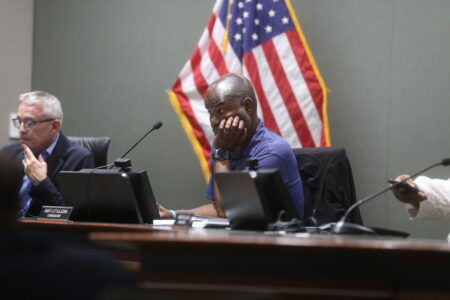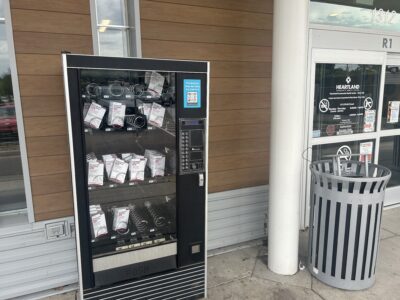City’s 2024 financial statements show expenses grew at nearly twice the rate of revenues
City also gives approval to duplex project in NW Lawrence

photo by: Chad Lawhorn/Journal-World
Lawrence City Commissioner Bart Littlejohn is pictured at a City Commission meeting on Aug. 5, 2025.
It was checkbook balancing time at Lawrence City Hall on Tuesday, and the records show a pretty clear story for 2024.
City expenses grew nearly twice as fast as revenues, and for every new dollar in spending, more than 60 cents of it went to public works projects.
City-hired auditors recently completed the city’s official financial statements for 2024, and commissioners received a briefing on the results at their Tuesday evening meeting. Among the key items in the end-of-year document:
• Total city spending increased by about $19 million to $268.4 million, up 7.6% from 2023 totals
• Total city revenues increased by about $11 million to $272.2 million, up 4.1% from a year earlier.
• Spending on public works projects — think roads, buildings, sidewalks and other such infrastructure — increased nearly $12 million to $37.7 million, an increase of 44% from 2023 totals.
• Property tax collections totaled $52.9 million, an increase of 8.1% from a year earlier.
• Water, sewer and trash fees charged by the city totaled $96.9 million, an increase of 11% from a year earlier.
• Revenue from operating grants totaled $15.9 million, down 29% from a year earlier when the city still had pandemic grant funds that it was spending down.
• Other taxes, which primarily include sales taxes charged on purchases made in Lawrence, totaled $70.2 million, up 2.6% from a year ago.
The numbers created a tale of two cities in 2024. The city’s general government operations — police, fire, roads, parks and recreation and other such services — operated at about a $14 million loss in 2024.
The city’s utility operations — primarily water, sewer and trash service — took in about $18 million more than they spent in 2024.
On the general government side of City Hall, the difference between what happened with expenses and revenues in 2024 was stark. Expenses grew by about 7%, while revenue grew by only 0.5%.
Residents who look only at their property tax bills may not have recognized that the city’s general revenues had a soft year in 2024. Property tax collections did increase at a rate faster than the city’s overall spending. While the city essentially held the property tax rate steady in 2024, property tax bills generally increased across the city as home values rose as Lawrence was hit by the national trend of demand for new housing outpacing the supply of homes.
The end result was that property tax revenues increased by 8% while spending overall increased by 7%. But those rising property tax dollars weren’t enough to keep the city’s finances balanced because property taxes are no longer the largest source that funds general city operations.
In 2024, property taxes funded just less than 30% of the city’s general government expenses. The largest funder of those expenses was sales tax collections, which covered nearly 40% of general government expenses last year.
However, sales taxes are also the revenue source that is hardest for city leaders to control. Sales tax collections depend heavily on the mood of consumers and how much they are buying during the course of the year. Plus — unlike property tax rates or utility rates — the sales tax rate can’t be changed via a simple vote of the City Commission. Rather, any change in the city’s sales tax rate must be approved as part of a citywide election.
In 2024 — as the Journal-World reported throughout the year — sales tax collections were slower than city officials had expected.
City spending did not slow nearly as much, and nowhere was that more evident than in the general category of public works projects. The 44%, $12 million increase in public works spending was by far the largest of any general category tracked by the city’s auditors.
No other spending category within the city’s general operations had more than a 7% increase for the year. Here’s a look at those categories:
• General government overhead: $24 million, up 6.5%
• Public safety: $70.1 million, up 0.7%
• Health and social services: $15.3 million, up 5.2%
• Culture and recreation: $28 million, up 3.6%
• Economic development and tourism: $4.4 million, up 0.5%
The spending on public works projects fits with a multiyear campaign at City Hall where City Manager Craig Owens and several commissioners have warned that the city’s infrastructure has degraded with age, and is in need of significant repair and upgrading in order to keep the city functioning smoothly in the future.
The spending on large and multiple construction projects or equipment purchases has been taking place across the spectrum of city operations, including roads, sidewalks, fire department equipment and water and sewer projects.
But again, the tale of two cities has played out with how those projects have been funded. The 44% increase in public works spending noted by the auditors generally does not include any of the construction projects for the water and sewer utilities. Those projects aren’t considered general government operations, but rather are considered business enterprise operations, which generally are defined as those operations primarily paid for by user fees rather than taxes.
Those business enterprise operations — the largest of which, by far, is the water and sewer department — have been covering their costs in ways that general city operations have not.
But water and sewer users have been paying a price for it.
Water and sewer rates generated about $6.8 million more in revenue for the city than they did a year earlier. That’s an increase of about 11%. While some of the additional revenue came from growth in the number of customers in the city, the financial reports acknowledged most of the increase was the result of rate increases implemented by the city. An exact breakdown of how much community growth contributed to the revenue bump versus rate increases wasn’t provided. But with general U.S. inflation in 2024 measuring about 3%, water and sewer customers likely saw rate increases about three times the rate of inflation last year.
The rising revenues helped fuel a larger bottom line for the water and sewer utility. Operating revenues exceeded operating expenses by $10.4 million in 2024, which was nearly a $2 million increase from a year ago.
City officials, though, are using some of the operating profits of the water and sewer operations to fund major infrastructure projects for the utilities. The largest City Hall project currently underway is a $70 million upgrade of the sewage treatment plant on the Kansas River.
The city already has spent about $42 million on that project, and has contracts for another $29 million worth of work at the sewer plant, according to the year-end financial report.
Citywide and across all departments, according to the financial reports, the city has contracts for 40 construction and infrastructure projects totaling $191 million. The city already has spent about $90 million on those contracts, and has about $101 million left on those contracts.
The sewer plant project is the largest, with about $29 million still left to spend, but closely behind is $28 million in remaining work for phase one of the new public works facility under construction near 19th Street and O’Connell Road in eastern Lawrence. That public works project ultimately is expected to cost about $100 million once its second phase is completed. That second phase, estimated to be about $50 million, isn’t included in the $191 million project list.
Other projects that are on that 2024 list include: $10.4 million for Iowa Street improvements; $8.1 million for Maple Lane sewer and water main improvements; $4.1 million for various sewer main projects; $4.1 million for various street maintenance projects; $2.7 million for Clinton Parkway road improvements; $2.6 million for various stormwater improvements; $2.4 million for chemical storage upgrades at the Clinton Water Treatment Plant; $2.1 million for water main supply at Eagle Bend Golf Course and YSC recreation complex.
In other business at Tuesday’s meeting, city commissioners:
• Approved a final development plan for Fall Creek Villas at the southwest corner of Kasold Drive and Tomahawk Drive in western Lawrence. The project is proposed to house 14 duplex homes adjacent to a creek. Neighbors had expressed concern about stormwater impacts that would be created by the new development, and city commissioners conditioned that the project receive final development plan approval from the City Commission — as opposed to city staff — due to those concerns. Commissioners approved the final development plan on a 3-2 vote, with Commissioners Lisa Larsen and Amber Sellers opposed. More than 15 members of the public spoke against the project, with concerns about flooding and loss of green space prevalent. A majority of commissioners voted for approval after the city’s engineering staff attested that the development wouldn’t worsen flooding conditions in the area for 100-year storms or smaller.
• Forwarded an application for a property tax rebate and other financial incentives from tech firm Alarm.com for staff review and a future recommendation. The company is seeking financial incentives to help fund a $3.5 million renovation of about 13,000 square feet in the former Journal-World printing plant at Sixth and Massachusetts. The company, which provides home and business security services, is proposing a nearly 70-person office in the space, with jobs ranging from $45,000 to $146,000 in annual wages, the company said in its application.
• Unanimously approved a tax abatement request for a $13 million project — The Peaks of Lawrence — that will provide 34 one-and two-bedroom apartment units that will be rent-controlled and set aside for residents 55 and over. The project also will include eight, market-rate apartment units. The project, planned for 5275 W. Sixth St., was seeking a 10-year, 65% property tax abatement. City staff recommended approval of the tax abatement request, saying it met the city economic development goals due to the new affordable housing units it would provide.
• About 20 members of the public spoke during the meeting’s public comment period protesting the implementation of a Lawrence Police Department program that creates a new link for the police department to cooperate with private residences or businesses that a have a personal security camera on their properties.
Public commenters told commissioners that the program didn’t get an appropriate hearing by the Lawrence City Commission, but rather was not fully understood when the commission approved a contract for technology related to the program several weeks ago. Commenters asked for the program to be paused until a full hearing could be had by the City Commission.
Commissioners, as is their practice for items brought up during the general public comment period, did not take any action on the request.






